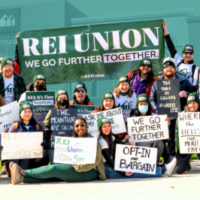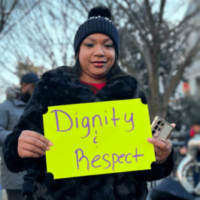Executive Summary
This summary includes an introduction to occupational segregation, a look at its impacts, and a broad set of policy recommendations to uproot occupational segregation and build a good-jobs economy.
Read our full report for a closer look at occupational segregation in the pre-pandemic labor market of 2019, the mechanisms that reinforce it, and the history of occupational segregation, including how key policy choices made a difference.
Occupational Segregation and the Good-Jobs Economy
All workers deserve economic security—the ability to count on just working conditions, benefits, and wages. No one’s race, ethnicity, or gender should determine their opportunities at work or economic life chances. That’s a belief held by the vast majority of U.S. adults—that all people should have equal opportunity.1 Yet the nation’s economy, founded on slave labor, continues to reflect structural racism built into the labor market and the workplace.
Occupational segregation is defined as the overrepresentation or underrepresentation of a demographic group in a certain occupation or field. As a result of occupational segregation, Black and Latinx workers are overrepresented in dangerous jobs, underpaying jobs, and jobs with few benefits.
Workers of color face higher unemployment rates and receive less support from unemployment insurance. They are more likely to experience workplace violations such as wage theft and to be employed in nonstandard work arrangements that lack workplace protections.
In nearly every case, women of color disproportionately face the worst work situations. There’s not a single cause of occupational segregation—a range of factors such as discrimination, societal norms, economic forces, and education compound and reinforce it.
Eliminating occupational segregation is absolutely necessary for creating a good-jobs economy, but it is not sufficient. To build an economy where everyone can thrive, policymakers must both remove structural barriers to mobility so that all workers have equal opportunity to move into jobs and also ensure that every job pays a living wage, offers robust benefits, and enables workers to play a role in shaping the rules they work under.
Overcoming occupational segregation and raising job standards are not impossible goals. Throughout history, workers and community members successfully organized and advanced policies and practices that led to substantial progress. For example, occupational segregation for Black workers—especially Black women—dramatically declined from 1940 to 1980. In the 1960s and 1970s, wages for Black workers rose dramatically. Researchers find that the victories won by civil rights activists, including anti-discrimination laws and affirmative action programs, played a significant role in reducing occupational segregation.2 Over the same period, workers and advocates won broader workplace protections, increases in unionization, and higher minimum wages, substantially boosting pay for Black workers and reducing racial wage gaps.3 The civil rights and workers’ rights struggles were often intertwined and reinforced each other.
However, conservative backlash to economic, racial, and gender progress contributed to a shift in policymaker priorities: Progress on reducing occupational segregation slowed after 1980 and ultimately stalled. Wage disparities between Black and white workers began to increase. Policymakers cut resources for enforcing anti-discrimination and worker protection laws, allowed the value of the federal minimum wage to erode, undermined the power of organized labor, and enabled a shift toward outsourcing and worker misclassification that eroded wages and job quality for workers of color and reinforced occupational segregation.
Impacts of the Segregated U.S. Labor Market
The United States today is far from offering a good-jobs economy: Instead, the labor market is built on a long-standing hierarchy where a worker’s race, gender, immigration status, and arrest or conviction record, along with other factors that have nothing do with capacity to do a job, determine who has access to good jobs and opportunities to thrive. Occupational segregation is an indicator of the staying power of white supremacy in the U.S. economy.
Harmful outcomes of occupational segregation include:
- Low pay: More than 20 million workers were paid less than $15 an hour in 2022. Women, Black, and Latinx workers were disproportionately likely to be paid wages this low: 20 percent of Black workers and 19 percent of Latinx workers were paid less than $15 an hour, compared to 13 percent of white workers.4 Among women workers, 18 percent were paid less than $15 an hour, compared to 12 percent of male workers.
- Fewer benefits: Black and Latinx workers are less likely than their white counterparts to have access to employer-sponsored health coverage5 and have less access to paid sick time or paid leave to care for a newborn or newly adopted child.6
- Unsafe working conditions: Black and Latinx workers are more likely to be employed in dangerous jobs and have a higher fatality rate than the national average.7 Permanent disabilities can result in lifetime earnings losses, with some workers losing up to 30 percent of their earnings even years after a workplace injury.8
- Violations of labor standards: Minimum wage laws and many other labor protections cover all people working in the U.S., but workers of color experience more violations in the workplace. Foreign-born Latinx workers have the highest minimum wage violation rates of all race/ethnic groups. Among U.S.-born workers, Black workers have a violation rate triple that of their white counterparts.9 Employers steal an estimated $15 billion every year from workers and their families through just one form of wage theft—minimum wage violations.10
- More unemployment: As a result of structural racism in the labor market, Black workers frequently confront unemployment rates twice as high as those of white workers. Sociologist Algernon Austin finds that Black workers consistently face higher unemployment rates compared to white workers with the same educational attainment, skills, or residential location, regardless of immigration, disability, or veteran status or involvement with the criminal legal system.11
- Less support from unemployment insurance: Black workers are less likely to receive unemployment benefits than white workers, and receive lower average benefits when they do obtain support.12 In total, Black workers who are eligible for unemployment benefits receive an estimated $1,299 less than eligible white workers in the first year of unemployment.13
- Employed in non-standard work arrangements with fewer workplace protections: Black and Latinx workers are disproportionately employed as temp and gig workers and are more often misclassified as independent contractors. As a result, they have less power in the workplace and less ability to push back against retaliation, harassment, and discrimination on the job.14 Workers in nonstandard arrangements also have less access to health and retirement benefits and lower wages: For example, full-time temporary help agency workers earn 41 percent less than workers in standard work arrangements, partly due to different occupational distributions.15
Occupational segregation was created by policy: The unequal labor market is rooted in the history of slavery and Jim Crow segregation, as well as exploitative immigration laws and sexist assumptions about acceptable roles for women that contribute to the devaluation of women’s labor.
As recently as 1963, it was entirely legal to discriminate on the basis of race and gender in hiring, and to pay women and workers of color less than men and white workers for the same work.
The history of occupational segregation in the U.S. demonstrates that when workers, community members, and advocates push for policies that desegregate opportunity and build worker power, they can succeed in making a concrete and substantial impact in reducing inequality, facilitating occupational mobility, increasing pay and benefits, and enabling workers to have a greater voice in the decisions that govern their working lives.
Yet history also shows that these gains are vulnerable to corporate counterattacks and to white supremacist and patriarchal backlash. The statistics above indicate how much more progress must be made. To build a good-jobs economy, policymakers must pursue policies that will both desegregate opportunity and make every job a good job.
Transformative Policy Can Uproot Occupational Segregation and Build a Good-Jobs Economy
To build a good-jobs economy where everyone can thrive, policymakers must both remove structural barriers to mobility so that all workers have equal opportunity to move into jobs and also ensure that every job pays a living wage, offers robust benefits, and enables workers to play a role in shaping the rules they work under. Federal, state, and local policymakers must advance the following policies.
In a good-jobs economy, race, gender, immigration, or justice-involved status don’t determine workers’ fate.
- Increase funding and staff at the Equal Employment Opportunity Commission and Office of Federal Contractor Compliance Programs, as well as state and local fair employment practices agencies.
- Prohibit employers from paying workers differently based on gender, race, or ethnicity when they perform substantially the same work; mandate pay transparency; and ban employers from asking about salary history.
- Revisit the use of audit testing (also known as matched-pair testing) by federal, state, and local fair employment practices agencies to identify hiring discrimination, promote employment opportunities, and advance racial equity.16 See NELP’s publication on audit testing.
- Curtail the use of arrest and conviction records and personal credit histories in hiring, firing, and promotions. See NELP’s work on fair chance hiring and employment.
- Adopt “clean slate” policies that automatically seal arrest and conviction records under certain circumstances, preventing discrimination based on justice-involved status and ensuring pathways for people with records to enter licensed professions. See NELP’s work on fair chance licensing.
- Expand fundamental worker protections, including the Fair Labor Standards Act and Occupational Health and Safety Act, to include incarcerated workers and workers re-entering communities.17 See NELP’s work on building power for criminalized workers.
- Ensure immigrant workers benefit from full worker protections and are shielded from retaliation. See NELP’s work on immigrant workers.
In a good-jobs economy, all jobs pay a living wage and one job is enough to pay the bills.
- Raise the federal and state minimum wages, index them to inflation, and provide resources to adequately investigate and enforce all wage laws. Phase out subminimum wages for tipped workers, young workers, and workers with disabilities.18 See NELP’s work on the minimum wage and NELP’s work on enforcement.
- Prevent employers from misclassifying workers as independent contractors, an illegal practice that is rampant in underpaid, labor-intensive industries. Adopt broad and clear tests for determining who is an employee and who is an independent contractor, and provide resources to increase enforcement of misclassification and raise penalties. See NELP’s work on stopping misclassification.
- Ensure that workplace protections, including minimum wages, whistleblower protections, and nondiscrimination laws, fully apply to contract workers as well as employees. See NELP’s work on contracting.
- Pass and enforce policies that ensure that companies that outsource labor to contractors while maintaining the right to control the work are held responsible as joint employers. See NELP’s work on joint employment.
- Strengthen the rights of temporary workers, including requiring that temporary workers receive the same pay and benefits as permanent employees. See NELP’s work on accountability in temp work.
- Guarantee that workers on the job for more than 40 hours per week receive overtime pay. See NELP’s work on overtime.
- Use the procurement authority of federal, state, and local governments to require minimum labor standards for companies that receive government contracts, including a higher minimum wage, minimum benefits, and requirements that workers are hired by the contractor or subcontractor as employees. See NELP’s work on public procurement.
In a good-jobs economy, all jobs include robust benefits.
- Guarantee paid family and medical leave to all workers. See NELP’s work on family and medical leave.
- Require all employers to provide workers with paid sick and safe leave. See NELP’s work on paid sick and safe leave.
- Ensure workers have a say in their work schedules. See NELP’s work on scheduling flexibility.
- Assure that all workers have access to health coverage, retirement benefits, childcare, education and training opportunities, and workers’ compensation, either through their employers or through universal social infrastructure.
In a good-jobs economy, anyone out of work can sustain themselves while they find a new job.
- Overhaul unemployment insurance to better support jobless workers at all times. See NELP’s work on unemployment insurance.
- Ensure that extended benefits and other emergency unemployment programs have effective and automatic triggers during periods of high unemployment. See NELP’s work on preparing unemployment insurance for recessions.
- Establish benefits to support jobless workers who aren’t eligible for unemployment insurance, including immigrant workers without authorization, people leaving incarceration, caregivers and other workers who recently reentered the workforce, students, and self-employed workers. See NELP’s work on excluded worker programs and on proposals for a job seekers’ allowance.
In a good-jobs economy, workers are not expendable or commodities, but rather are actively shaping the rules of the game.
- Promote stability and security for workers by ending unjust and arbitrary firings. See NELP’s work on just-cause job protections.
- Strengthen workers’ ability to form unions and collectively bargain a contract. See NELP’s work on union organizing.
- Eliminate the use of forced arbitration and class action waivers in employment and civil rights disputes, restoring workers’ right to have their day in court. See NELP’s work on forced arbitration.
- Ban or severely limit the use of noncompete agreements and training-repayment-agreement provisions that companies use to block workers from changing jobs. See NELP’s work on how noncompetes limit economic mobility.
- Guarantee robust health and safety protections for workers, including a real and substantive right to refuse dangerous work. Provide resources to adequately investigate and enforce occupational health and safety laws. See NELP’s work on workplace health and safety and what a meaningful right to refuse dangerous work should include.
- Ensure workers have an avenue to meaningfully enforce their workplace rights by building and supporting collaborations between worker centers, worker advocacy organizations, and state and federal labor officials. See NELP’s work on strategic enforcement partnerships.
- Protect workers from retaliation when they speak up about wage theft, harassment, discrimination, and other workplace abuses. See NELP’s work on protecting whistleblowers.
- Regulate employers’ growing use of electronic surveillance and algorithmic management of workers to require greater transparency and worker input. See NELP’s work on automated worker surveillance and management practices.
Related to
- Cruz Fox and David Schleifer, American Perspectives on Racism and Racial Justice (Brooklyn, NY: Public Agenda, 2023), https://publicagenda.org/wp-content/uploads/PA-Racial-Justice-Religion-and-Spirituality-Report_FINAL.pdf.
- Fidan Ana Kurtulus, “The Impact of Affirmative Action on the Employment of Minorities and Women,” Journal of Policy Analysis and Management 35, no. 1 (Winter 2016), https://doi.org/10.1002/pam.21881; Donald Tomaskovic-Devey and Kevin Stainback, “Discrimination and Desegregation: Equal Opportunity Progress in U.S. Private Sector Workplaces since the Civil Rights Act,” The Annals of the American Academy of Political and Social Science 609, no. 1 (January 2007), https://doi.org/10.1177/0002716206294809; Joni Hersch and Jennifer Bennett Shinall, “Fifty Years Later: The Legacy of the Civil Rights Act of 1964,” Journal of Policy Analysis and Management 34, no. 2 (Spring 2015), https://doi.org/10.1002/pam.21824.
- Ellora Derenoncourt and Claire Montialoux, “Minimum Wages and Racial Inequality,” Quarterly Journal of Economics 136, no. 1 (February 2021), https://doi.org/10.1093/qje/qjaa031.
- Elise Gould and Katherine deCourcy, Low-Wage Workers Have Seen Historically Fast Real Wage Growth in the Pandemic Business Cycle (Washington, DC: Economic Policy Institute, March 23, 2023), https://www.epi.org/publication/swa-wages-2022/.
- Latoya Hill, Samantha Artiga, and Anthony Damico, Health Coverage by Race and Ethnicity, 2010–2022 (San Francisco, CA: KFF, January 11, 2024), https://www.kff.org/racial-equity-and-health-policy/issue-brief/health-coverage-by-race-and-ethnicity/.)) and retirement plans,((David John, Gary Koenig, and Marissa Malta, Payroll Deduction Retirement Programs Build Economic Security (Washington, DC: AARP Public Policy Institute, July 2022), https://www.aarp.org/content/dam/aarp/ppi/2022/07/payroll-deduction-retirement-programs-build-economic-security.doi.10.26419-2Fppi.00164.001.pdf.
- Chantel Boyens, Michael Karpman, and Jack Smalligan, Access to Paid Leave Is Lowest among Workers with the Greatest Needs (Washington, DC: Urban Institute, July 14, 2022), https://www.urban.org/research/publication/access-paid-leave-lowest-among-workers-greatest-needs.
- Rebecca L. Reindel and MK Fletcher, Death on the Job: The Toll of Neglect (Washington, DC: AFL-CIO, April 2023), https://aflcio.org/sites/default/files/2023-04/2303_DOTJ_2023_final%20%283%29.pdf.
- Does The Workers’ Compensation System Fulfill Its Obligations to Injured Workers? (Washington, DC: U.S. Department of Labor, September 23, 2016), https://www.dol.gov/sites/dolgov/files/OASP/WorkersCompensationSystemReport.pdf; Seth A. Seabury, Sophie Terp, and Leslie I. Boden, “Racial and Ethnic Differences in the Frequency of Workplace Injuries and Prevalence of Work-Related Disability,” Health Affairs 36, no. 2 (February 2017), https://www.healthaffairs.org/doi/10.1377/hlthaff.2016.1185.
- Annette Bernhardt, Ruth Milkman, and Nik Theodore, et. al., Broken Laws, Unprotected Workers: Violations of Employment and Labor Laws in America’s Cities (New York, NY: National Employment Law Project, September 21, 2009), https://www.nelp.org/publication/broken-laws-unprotected-workers-violations-of-employment-and-labor-laws-in-americas-cities/.
- David Cooper and Teresa Kroeger, Employers Steal Billions from Workers’ Paychecks Each Year (Washington, DC: Economic Policy Institute, May 10, 2017), https://www.epi.org/publication/employers-steal-billions-from-workers-paychecks-each-year/.
- Algernon Austin, The Continuing Power of White Preferences in Employment (Washington, DC: Center for Economic and Policy Research, August 1, 2023), https://cepr.net/report/the-continuing-power-of-white-preferences-in-employment/.
- Amy Traub and Kim Diehl, Reforming Unemployment Insurance Is a Racial Justice Imperative (New York, NY: National Employment Law Project, February 28, 2022), https://www.nelp.org/publication/reforming-unemployment-insurance-is-a-racial-justice-imperative/.
- Elira Kuka and Bryan A. Stuart, Racial Inequality in Unemployment Insurance Receipt and Take-Up, (Philadelphia, PA: Federal Reserve Bank of Philadelphia, 2022), https://www.philadelphiafed.org/-/media/frbp/assets/working-papers/2022/wp22-09.pdf.
- Independent Contractor Misclassification Imposes Huge Costs on Workers and Federal and State Treasuries, (New York, NY: National Employment Law Project, October 2020), https://www.nelp.org/publication/independent-contractor-misclassification-imposes-huge-costs-workers-federal-state-treasuries-update-october-2020/; Rey Fuentes, Rebecca Smith, and Brian Chen, Rigging the Gig, (New York, NY: Partnership for Working Families and National Employment Law Project, July 2020), https://s27147.pcdn.co/wp-content/uploads/Rigging-the-Gig_Final-07.07.2020.pdf.
- “America’s Nonstandard Workforce Faces Wage, Benefit Penalties, According to U.S. Data,” (National Employment Law Project, June 7, 2018), https://www.nelp.org/news-releases/americas-nonstandard-workforce-faces-wage-benefit-penalties-according-us-data.
- Darrick Hamilton and Rebecca Dixon, Shifting the Burden of Proof, (Institute on Race, Power and Political Economy at the New School for Social Research and the National Employment Law Project, 2022), https://www.nelp.org/wp-content/uploads/Shifting-the-Burden-of-Proof_Using-Audit-Testing-to-Proactively-Root-Out-Workplace-Discrimination_Sept22.pdf.
- Han Lu, Worker Power in the Carceral State (New York, NY: National Employment Law Project, August 2022), https://www.nelp.org/wp-content/uploads/Worker-Power-in-the-Carceral-State-10-Proposals.pdf.
- Why the U.S. Needs at Least a $17 Minimum Wage, (National Employment Law Project and the Economic Policy Institute, July 2023), https://www.nelp.org/publication/why-the-us-needs-at-least-a-17-minimum-wage/.





